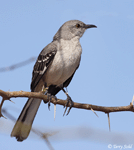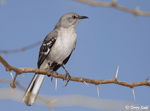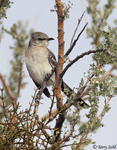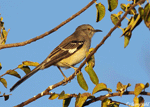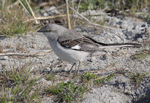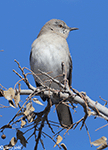| Length: 10.5 inches | Wingspan: 15 inches | Seasonality: Summer / Migrant |
| ID Keys: Gray overall, white wing patches, long tail, short dark bill. | ||
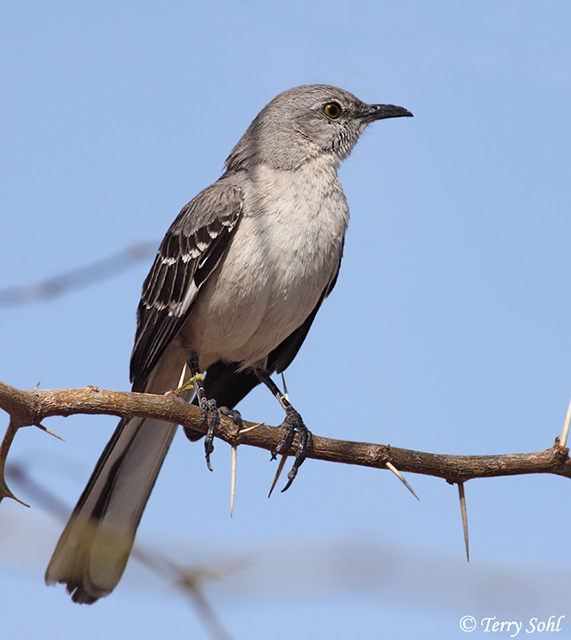 One of the ultimate
imitators, the Northern Mockingbird is able to imitate not only the songs of
many species of birds, but may sometimes repeat other sounds from the meow of a
cat to the tinkle of wind chimes. The Northern Mockingbird is a bold
defender of its nest site, attempting to chase away anything (including people)
that come too close for its comfort. South Dakota is at the northern edge
of its range, although it has been expanding its range to the north in recent
decades. They are increasingly rare as one moves northward from the
Nebraska/South Dakota border.
One of the ultimate
imitators, the Northern Mockingbird is able to imitate not only the songs of
many species of birds, but may sometimes repeat other sounds from the meow of a
cat to the tinkle of wind chimes. The Northern Mockingbird is a bold
defender of its nest site, attempting to chase away anything (including people)
that come too close for its comfort. South Dakota is at the northern edge
of its range, although it has been expanding its range to the north in recent
decades. They are increasingly rare as one moves northward from the
Nebraska/South Dakota border.
Habitat:
Northern Mockingbirds can be found in a variety of habitats, but prefer mixed habitats with open ground and dense thickets and shrubs, including fencerows, riparian areas, residential areas, and roadsides.
Diet:
Mostly insects and fruit. The diet in the summer generally primarily consists of animal protein, particularly while raising young. Opportunists, their protein-based diet may also include earthworms, snails, small crustaceans, and small vertebrates such as amphibians and lizards. The diet outside the breeding season may shift to a heavier proportion of vegetable matter.
Behavior:
Does much of its foraging by walking on the ground. Will also observe from a perch and fly out to capture insects spotted on the ground or in vegetation below.
Nesting:
June and July. Northern Mockingbirds may nest in a variety of shrubs and trees, generally 5 to 10 feet from the ground but sometimes much higher. The male initiates breeding by typically constructing multiple "starter nests", letting his mate choose the nest site she deems most suitable. The male's starter nest is a loose construction of twigs, which the female then firms up and develops into a cup, lined with finer material that may include almost any vegetative or other material near the nest site, including grasses, roots, weed stems, hair, feathers, or bits of man-made material. The female lays between 3 and 12 eggs, with she alone incubating them. The young hatch after about 12 to 14 days, with both parents helping to feed them. However, Northern Mockingbirds sometimes produce more than one brood per breeding season, and the female may leave the first nest while the young still haven't fledged, finishing another of the male's starter nests, laying new eggs, and initiating a 2nd brood. The male finishes raising the first brood's young in this situation.
Songs / Calls:
As the name implies, Northern Mockingbirds are incredibly skilled vocalists, capable of an extremely wide array of calls and songs. The typical song of a Northern Mockingbird is a long series of varied phrases, with each phrase often repeated 2 or 3 times, and then a slight pause as they shift to a different phrase. Given Northern Mockingbirds can provide calls that sounds like whistles, musical warbling, nasal whining, harsh chattering, and a variety of other sounds, the songs and vocalizations can be unpredictable and even vary widely between birds found in the same area. That unpredictability becomes even more pronounced given that Northern Mockingbirds often learn the songs of the birds around them, or even the vocalizations of frogs and other animals.
Here are some example vocalizations of a Northern Mockingbird:
- Click here to hear a short seer call of a Northern Mockingbird1
- Click here to hear a quite variable song of a Northern Mockingbird2
- Click here to hear chattering alarm calls of a Northern Mockingbird3
- Click here to hear another song version of a Northern Mockingbird4
- Click here to hear one more song version of a Northern Mockingbird5
Migration:
Generally a permanent resident throughout its range, with some northern birds moving south in the fall.
Interactive eBird Map:
Click here to access an interactive eBird map of Northern Mockingbird sightings
Bird Feeders:
Northern Mockingbirds will sometimes attend feeders for fruit, suet, and bread.
Similar Species:
Size and structure differentiate the Northern Mockingbird from some other "gray" songbirds, but there are a few species that might possible cause some identification challenges in the normal range of the species:
- Townsend's Solitaire - Townsend's Solitaire have a broad range in western North America, where they may cross paths with Northern Mockingbird. In South Dakota, they are permanent residents in higher-elevation parts of the Black Hills, but are winter visitors elsewhere. In terms of appearance, Townsend's Solitaire are grayish overall with darker wings. However, unlike a Northern Mockingbird, they have an obvious white eye-ring, and have more consistent gray coloring on both their upperparts and underparts, compared to the darker upperparts and lower upperparts of the Mockingbird. Wings are also different, as Townsend's Solitaire have plainer looking wings without the white wing bars of a Northern Mockingbird. Finally, the bill of a Townsend's Solitaire is noticeably smaller and straighter than that of a Northern Mockingbird.
- Gray Catbird - Gray Catbirds have a broad range in North America and cross paths with the Northern Mockingbird in parts of the western US in the summer months. Gray Catbirds have an obvious black cap and a rusty undertail coloring that are both lacking on a Northern Mockingbird. Conversely, Northern Mockingbirds have black on the wings with white wingbars, both features lacking on a Gray Catbird.
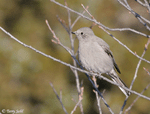 |
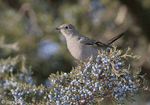 |
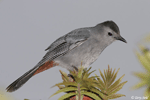 |
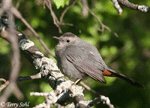 |
| Townsend's Solitaire | Townsend's Solitaire | Gray Catbird | Gray Catbird |
Conservation Status:
Northern Mockingbirds were once captured for the pet trade, and wild populations sharply declined. Numbers have increased since then, and systematic surveys over the last few decades show generally stable populations. There are some indications that they are now expanding their range to the north as well. Overall, they are found across a very broad geographic area, are common in parts of that range, and overall numbers are strong. The IUCN considers the Northern Mockingbird to be a species of "Least Concern".
Further Information:
- USGS Patuxent Bird Identification InfoCenter, Northern Mockingbird
- WhatBird - Northern Mockingbird
- Audubon Guide - Northern Mockingbird
Photo Information:
March 26th, 2009 - Henderson Bird Viewing Preserve, Henderson, Nevada -- Terry L. Sohl
Additional Photos:
Click on the image chips or text links below for additional, higher-resolution Northern Mockingbird photos.
Audio File Credits:
- 1William Whitehead. Recorded in Monmouth County, New Jersey on October 23rd, 2020. Original recording and information available from xeno-canto.
- 2Isain' Contreras Rodriguez. Recorded in Sinaloa, Mexico on February 26th, 2020. Original recording and information available from xeno-canto.
- 3JL Guerra. Recorded in Cuba on September 17th, 2019. Original recording and information available from xeno-canto.
- 4Omar Suarez Garcia. Recorded in Oaxaca, Mexico on September 23rd, 2018. Original recording and information available from xeno-canto.
- 5Manuel Grosselet. Recorded in Nuevo Leon, Mexico, on May 14th, 2017. Original recording and information available from xeno-canto.
| Click on the map below for a higher-resolution view |
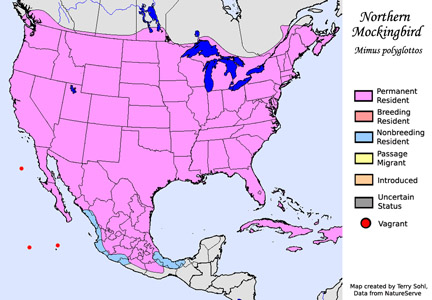 |
| South Dakota Status: Rare migrant and summer resident. Honestly, the range map above is pretty optimistic on the northern part. While birds may appear in South Dakota and points northward, they're not generally considered "permanent" breeding birds by any means in most far northern areas depicted on this map. |
Additional Northern Mockingbird Photos
Click for a higher-resolution version of these photos

